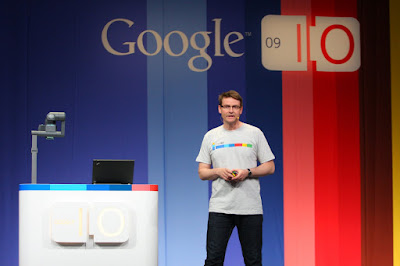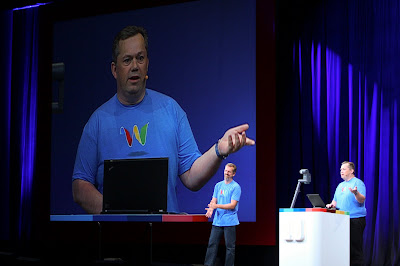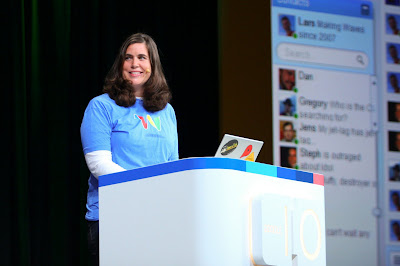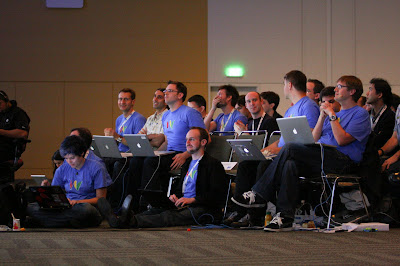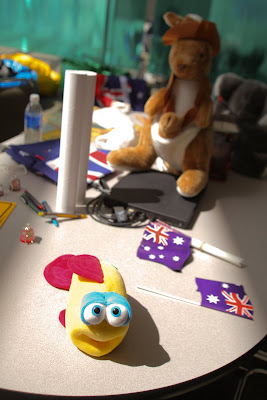Seo Master present to you:

One of the best things about attending Google I/O is the chance to meet developers who are using our APIs and interacting with Google technology in ways we could never imagine. Not only was it amazing to see exciting examples of apps built on the AJAX and Data APIs being demoed at the developer sandbox, but it was also interesting to meet other developers who are just starting to use many of our APIs for their specific needs and cool ideas. Hopefully, by making all of our sessions available for free to watch on your own time, many of you who are interested in Google's APIs will get a better understanding of the ways we are making our API offerings easier to use, more efficient and much more feature rich.
Big Announcements & MoreOne of the most exciting announcements at this year's I/O was the developer preview of Google Wave. After its introduction during the
Day 2 keynote, there were three sessions devoted to the Google Wave APIs:
Programming With and For Google Wave,
Google Wave: Powered by GWT, and
Google Wave: Under the hood. We hope you're as excited as we are, and can't wait to see how you use these tools.
Another new product announcement this year was
Google Web Elements, which allow you to easily add your favorite Google products onto your own website. There are elements for Google News, Maps, Spreadsheets, YouTube and others, with more to come. Be sure to check out the
Day 1 keynote for a complete introduction to the simple copy and paste power of Google Web Elements.
Keeping webmasters in mind, two sessions were all about optimizing your site for search. In
one talk, Matt Cutts reviewed real sites that *you* submitted. talking through real-life issues that effect developers when it comes to optimizing their app for search. The
other session focused on how to maximize your site, your content, and your application's exposure to search engines.
Javascript & Google AJAX APIsThe session on
Custom Search Engines focused on helping your users search the sites and topics that are relevant to you. Nick Weininger discussed some of the ways to embed search and ads onto your site (including the new
Custom Search element), then customize the look and feel of the results. Adobe was on hand to show how they're using Custom Search Engines to enhance their products and insert contextual search into the developer's programming workflow. We also announced the launch of the
Custom Search gadget for Blogger which gives your blog's visitors the ability to search not just your posts, but web pages linked from your blog, your blog lists, and link lists.
In the session
Implementing your Own Visualization Datasource, attendees learned about building a server-side data source compatible with the Google Visualization API, including hearing about the experience from a Salesforce.com expert. Itai Raz also gave a
great session on using the Visualization API with GWT and treated the audience to advanced Javascript tricks such as wrapping visualizations as gadgets.
Ben Lisbakken's
session detailed some advanced Javascript techniques and then delved into some of great tips and tracks he learned while creating the
Code Playground, a tool which can help developers learn about and experiment with many of Google's APIs. Some of the highlights include increasing the security and performance of applications and learning why App Engine is so easy on which to develop.
Jon Kragh of
VastRank showed off some neat ways he's
Using AJAX APIs to Navigate User-Generated Content, including using Google Maps to display nearby colleges and translating reviews into the viewer's language. Also, Michael Thompson explored the idea of
Building a Business with Google's free APIs using example Google Gadgets, Google Gadget Ads, Mapplets, and the Maps API.
Google Data APIsJeff Fisher and Jochen Hartmann spoke on the
future direction of the YouTube API as it becomes increasingly social. They used two sample applications to demonstrate the use of the activity feeds as well as the new "SUP" feed that allows high traffic websites to monitor YouTube for activity in a scalable manner.
The session about
writing monetizable YouTube apps focused on creating applications that allowed access to YouTube videos in creative ways. In the talk, Kuan Yong showed how to expertly navigate through the YouTube API terms of service in order to avoid business pitfalls so that developers can monetize their own apps.
Eric Bidelman and Anil Sabharwal
discussed the Document List Data API in detail, highlighting common enterprise use cases such as sync, migration, sharing, and legal discovery. Partners
Syncplicity,
OffiSync, and
gDocsBar showed off compelling demos.
In the talk on the
evolution of the Google Data protocol, Sven Mawson outlined all of the new features in the Google Data APIs that will help in the creation of more efficient applications. Two of the new additions included a compact and customizable JSON output and the option to retrieve only the parts of a feed that you want using partial GET.
Monsur Hossain and Eric Bidelman
showed how to build a read/write gadget using OAuth and the
Google Data JavaScript library. They went through a step by step set of instructions that explained how to set up the gadget code, how to get a token using the OAuth proxy, and how to read and write data to Blogger using the JavaScript library inside of an
iGoogle gadget.
Google Geo APIsMano Marks and Pamela Fox started with a
grab bag session covering the vast spectrum of Geo APIs, discussing touring and HTML 5 in KML, the
Sketchup Ruby API (with an awesome physics demo), driving directions (did you know you can solve the Traveling Salesman Problem in Javascript?), desktop AIR applications, reverse geocoding, user location, and monetization using the
Maps Ad Unit and
GoogleBar. Pamela finished by sneak previewing an upcoming feature in the Flash API: 3d perspective view.
In the session on
performance tips for Maps API mashups, Marcelo Camelo announced
Google Maps API v3, a latency-oriented rewrite of our popular JS Maps API. Also see Susannah Raub's
more in-depth talk about Maps API v3. Then Pamela gave advice on how to load many markers (by using a lightweight marker class, clustering, or rendering a clickable tile layer) and on how to load many polys (by using a lightweight poly class, simplifying, encoding, or rendering tiles). Sascha Aickin, an engineer at
Redfin, showed how they were able to display 500 housing results on their real estate search site by creating the "SuperMarker" class.
Mano and Keith presented various ways of
hosting geo data on Google infrastructure: Google Base API, Google App Engine, and the just-released Google Maps data API. Jeffrey Sambells showed how
ConnectorLocal used the API (and their own custom PHP wrapper) for storing user data.
On the same day as announcing
better integration between the Google Earth and Google Maps JS APIs, Roman Nurik presented on
advanced Earth API topics, and released a
utility library for making that advanced stuff simple.
By Adam Feldman and Brandon Bilinski, Google Developer Team2013, By: Seo Master








